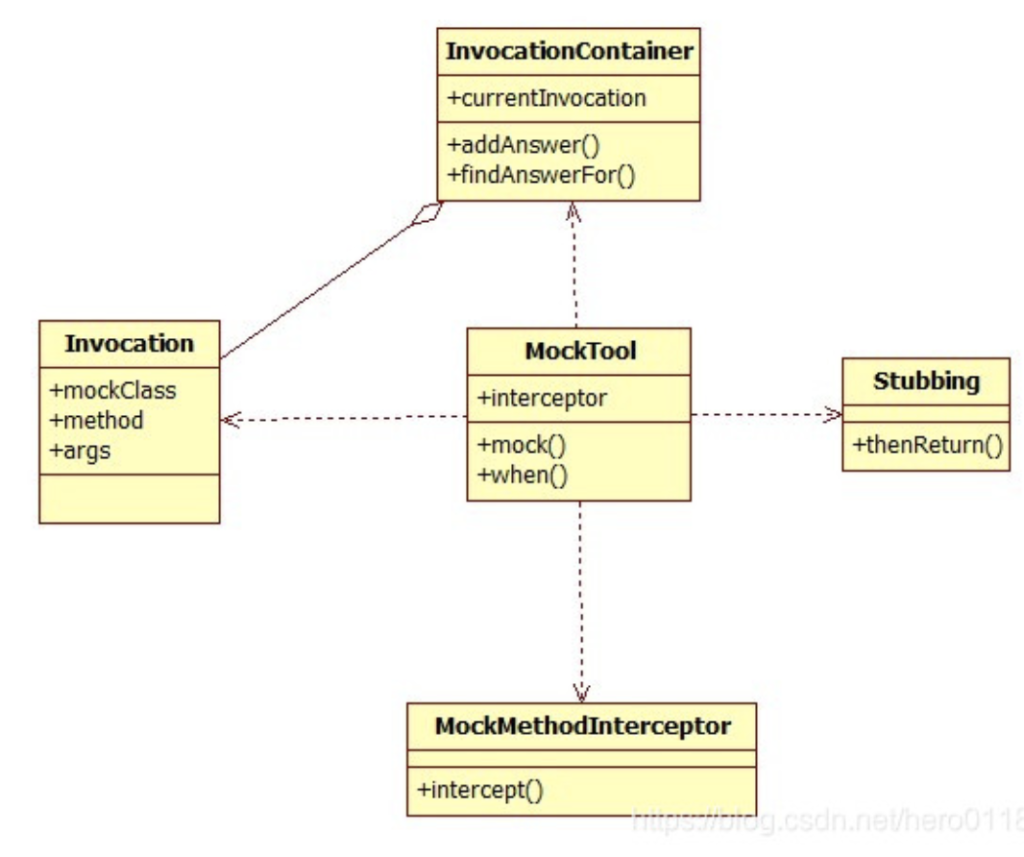在微服务横行的年代,一个服务可能依赖了若干个其它服务,而这些被依赖的服务,又极可能依赖了别的服务,于是构成了一个复杂的依赖链。而日常开发中,经常会苦恼于某某上游接口没数据而所使得UT达不到预期的目标,所兴现在已经有了多种Mock Toolkit,很好的解决了这一痛点。比较常用的有EasyMock,JMockit,Mockito,PowerMock等,而本文主要介绍Mockito的简单使用,并对其实现原理进行简单分析。
Mockito的使用
通常情况下,我们会在UT里使用@Mock、@Spy以及@InjectMocks等注解来Mock掉一些不可控的上下游接口,为了简化说明,我们将例子简单化。
假设有这样的一个服务
public class ServiceA {
@Autowired
private ServiceB serviceB;
public String hello(String name) {
return "ServiceA.hello:" + name;
}
public String helloB(String name) {
return serviceB.hello(name);
}
}
@Mock
现在我们来将它mock掉
public class MockTest {
@Mock
private ServiceA seriveA;
@Before
public void init() {
MockitoAnnotations.initMocks(this);
}
@Test
public void testA() {
Mockito.when(seriveA.hello("aaa")).thenReturn("111").thenReturn("222"); //打桩
System.out.println(seriveA.hello("aaa")); //111 //真实调用
System.out.println(seriveA.hello("aaa")); //222
System.out.println(seriveA.hello("bbb")); //null
}
}
为了便于描述,先简单说明一下:上面serviceA.hello(“aaa”)调用结果做为入参传递给when()方法,我们称为打桩,而后面的调用是我们称为真实调用。
Mockito提供了通俗易用的API,@Mock注释用于对目标对象进行mock,生成立mock对象,when…thenReturn…用于模拟返回结果,当调用某某方法时返回我们想要的预定结果, thenThrow则用于模拟目标方法抛出异常,而我们也可以使用方法链模拟返回多个mock结果,在多次调用目标方法时,Mockito会依次为我们返回预先设定的mock结果。
@InjectMocks
ServiceA依赖了ServiceB,如果我们要mock的不是ServiceA,而是ServiceB,那我们可以在UT里,给ServiceB加注释@Mock,给ServiceA加上注释@InjectMocks,这时Mockito会自动为ServiceA注入mock对象ServiceB
public class MockTest2 {
@InjectMocks
private ServiceA serviceA;
@Mock
private ServiceB serviceB;
@Before
public void init() {
MockitoAnnotations.initMocks(this);
}
@Test
public void testB() {
Mockito.when(serviceB.hello("aaa")).thenReturn("111").thenReturn("222");
System.out.println(serviceA.helloB("aaa")); //111
System.out.println(serviceA.helloB("aaa")); //222
System.out.println(serviceA.helloB("bbb")); //null
}
}
从上面的用法中,整个mock的过程大概可以分为三步:
- 1)@Mock注解声明了要将对象进行mock。
- 2)使用MockitoAnnotations.initMocks告诉Mockito要对当前对象进行mock处理。当然你用可以使用@RunWith(MockitoJUnitRunner.class),殊途同归。
- 3)使用when…thenReturn来模拟返回。
接下来我们来分析一下其实现原理。
Mockito的实现原理
mock对象的创建
首先我们看看MockitoAnnotations.initMocks到底做了什么?一起进入源码。
public static void initMocks(Object testClass) {
if (testClass == null) {
throw new MockitoException("testClass cannot be null. For info how to use @Mock annotations see examples in javadoc for MockitoAnnotations class");
}
AnnotationEngine annotationEngine = new GlobalConfiguration().getAnnotationEngine();
Class<?> clazz = testClass.getClass();
//below can be removed later, when we get read rid of deprecated stuff
if (annotationEngine.getClass() != new DefaultMockitoConfiguration().getAnnotationEngine().getClass()) {
//this means user has his own annotation engine and we have to respect that.
//we will do annotation processing the old way so that we are backwards compatible
while (clazz != Object.class) {
scanDeprecatedWay(annotationEngine, testClass, clazz);
clazz = clazz.getSuperclass();
}
}
//anyway act 'the new' way
annotationEngine.process(testClass.getClass(), testClass);
}
这里有个AnnotationEngine,从名称中我们大概可以猜到Mockito是要对Annotation比如:@Mock,@Spy,@InjectMocks等进行处理,以此创建出Mock对象。
AnnotationEngine有三个实现,DefaultAnnotationEngine,SpyAnnotationEngine,InjectingAnnotationEngine,这三个AnnotationEngine合分别处理@Mock、@Spy和InjectMocks注解。这里选择DefaultAnnotationEngine进行分析。
public void process(Class<?> clazz, Object testInstance) {
Field[] fields = clazz.getDeclaredFields();
for (Field field : fields) {
boolean alreadyAssigned = false;
for(Annotation annotation : field.getAnnotations()) {
Object mock = createMockFor(annotation, field);
if (mock != null) {
throwIfAlreadyAssigned(field, alreadyAssigned);
alreadyAssigned = true;
try {
new FieldSetter(testInstance, field).set(mock);
} catch (Exception e) {
throw new MockitoException("Problems setting field " + field.getName() + " annotated with "
+ annotation, e);
}
}
}
}
}
在这里看到createMockFor,由于代码还比较长,略去代码,直接看下面的流程图

从流程是我们大概知道,MockitoAnnotations.initMocks(this)的过程就是创建mock对象的过程,Mockito在1.x版本中是采用cglib动态创建被mock的目标类的代理类(2.x版本改用了bytebuddy),代理类是被mock目标类的子类,因此Mocktio无法mock被定义为final的类和方法(在3.4版本以后,Mockito可以Mock final的类和方法)。而在创建目标mock对象时,Mocktio利用cglib给mock对象加上了方法拦截器(MethodInterceptorFilter),这样当mock对象的方法被调用时,会被拦截器进行拦截处理。其中关键的代理类的生成和对象实例是创建是在ClassImposterizer中完成的,代码如下:
public Class<Factory> createProxyClass(Class<?> mockedType, Class<?>... interfaces) {
if (mockedType == Object.class) {
mockedType = ClassWithSuperclassToWorkAroundCglibBug.class;
}
Enhancer enhancer = new Enhancer() {
@Override
@SuppressWarnings("unchecked")
protected void filterConstructors(Class sc, List constructors) {
// Don't filter
}
};
Class<?>[] allMockedTypes = prepend(mockedType, interfaces);
enhancer.setClassLoader(SearchingClassLoader.combineLoadersOf(allMockedTypes));
enhancer.setUseFactory(true);
if (mockedType.isInterface()) {
enhancer.setSuperclass(Object.class);
enhancer.setInterfaces(allMockedTypes);
} else {
enhancer.setSuperclass(mockedType);
enhancer.setInterfaces(interfaces);
}
enhancer.setCallbackTypes(new Class[]{MethodInterceptor.class, NoOp.class});
enhancer.setCallbackFilter(IGNORE_BRIDGE_METHODS);
if (mockedType.getSigners() != null) {
enhancer.setNamingPolicy(NAMING_POLICY_THAT_ALLOWS_IMPOSTERISATION_OF_CLASSES_IN_SIGNED_PACKAGES);
} else {
enhancer.setNamingPolicy(MockitoNamingPolicy.INSTANCE);
}
enhancer.setSerialVersionUID(42L);
try {
return enhancer.createClass();
} catch (CodeGenerationException e) {
if (Modifier.isPrivate(mockedType.getModifiers())) {
throw new MockitoException("\n"
+ "Mockito cannot mock this class: " + mockedType
+ ".\n"
+ "Most likely it is a private class that is not visible by Mockito");
}
throw new MockitoException("\n"
+ "Mockito cannot mock this class: " + mockedType
+ "\n"
+ "Mockito can only mock visible & non-final classes."
+ "\n"
+ "If you're not sure why you're getting this error, please report to the mailing list.", e);
}
}
private Object createProxy(Class<Factory> proxyClass, final MethodInterceptor interceptor) {
Factory proxy;
try {
proxy = instantiator.newInstance(proxyClass);
} catch (InstantationException e) {
throw new MockitoException("Unable to create mock instance of type '" + proxyClass.getSuperclass().getSimpleName() + "'", e);
}
proxy.setCallbacks(new Callback[] {interceptor, SerializableNoOp.SERIALIZABLE_INSTANCE });
return proxy;
when().thenReturn()
分析完mock对象的构建,接下来说when()…thenReturn()…,其中when()方法入参是Object对象,我们一般是先调用目标方法然后将其返回值传给when()(该步骤也被称为打桩),而对目标方法的调用会先被拦截器(MethodInterceptorFilter)拦截,最后由MockHandlerImpl进行处理,代码如下:
public Object handle(Invocation invocation) throws Throwable {
if (invocationContainerImpl.hasAnswersForStubbing()) {
// stubbing voids with stubVoid() or doAnswer() style
InvocationMatcher invocationMatcher = matchersBinder.bindMatchers(
mockingProgress.getArgumentMatcherStorage(),
invocation
);
invocationContainerImpl.setMethodForStubbing(invocationMatcher);
return null;
}
VerificationMode verificationMode = mockingProgress.pullVerificationMode();
InvocationMatcher invocationMatcher = matchersBinder.bindMatchers(
mockingProgress.getArgumentMatcherStorage(),
invocation
);
mockingProgress.validateState();
// if verificationMode is not null then someone is doing verify()
if (verificationMode != null) {
// We need to check if verification was started on the correct mock
// - see VerifyingWithAnExtraCallToADifferentMockTest (bug 138)
if (((MockAwareVerificationMode) verificationMode).getMock() == invocation.getMock()) {
VerificationDataImpl data = createVerificationData(invocationContainerImpl, invocationMatcher);
verificationMode.verify(data);
return null;
} else {
// this means there is an invocation on a different mock. Re-adding verification mode
// - see VerifyingWithAnExtraCallToADifferentMockTest (bug 138)
mockingProgress.verificationStarted(verificationMode);
}
}
// prepare invocation for stubbing
invocationContainerImpl.setInvocationForPotentialStubbing(invocationMatcher);
OngoingStubbingImpl<T> ongoingStubbing = new OngoingStubbingImpl<T>(invocationContainerImpl);
mockingProgress.reportOngoingStubbing(ongoingStubbing);
// look for existing answer for this invocation
StubbedInvocationMatcher stubbedInvocation = invocationContainerImpl.findAnswerFor(invocation);
if (stubbedInvocation != null) {
stubbedInvocation.captureArgumentsFrom(invocation);
return stubbedInvocation.answer(invocation);
} else {
Object ret = mockSettings.getDefaultAnswer().answer(invocation);
// redo setting invocation for potential stubbing in case of partial
// mocks / spies.
// Without it, the real method inside 'when' might have delegated
// to other self method and overwrite the intended stubbed method
// with a different one. The reset is required to avoid runtime exception that validates return type with stubbed method signature.
invocationContainerImpl.resetInvocationForPotentialStubbing(invocationMatcher);
return ret;
}
}
主要逻辑是判断当前的调用是打桩还是真实调用,如果是打桩,则将当前调用信息(Invocation)交给InvocationContainerImpl进行记录,如果不是,则从InvocationContainerImpl中查找StubbedInvocationMatcher,而StubbedInvocationMatcher维护着一个由mock方法的mock结果组成的队列,可以根据客户端的调用依次返回mock结果。
thenReturn()是OngoingStubbing接口定义的方法,由BaseStubbing抽象类实现,并最终会调用OngoingStubbingImpl的thenAnswer(),最后将mock交给InvocationContainerImpl进行记录。OngoingStubbingImpl部分源码如下:
public OngoingStubbing<T> thenAnswer(Answer<?> answer) {
if(!invocationContainerImpl.hasInvocationForPotentialStubbing()) {
new Reporter().incorrectUseOfApi();
}
invocationContainerImpl.addAnswer(answer);
return new ConsecutiveStubbing<T>(invocationContainerImpl);
}
整个when().thenReturn()的过程如下:

执行完when()…thenReturn…,则完成了打桩,接下来调用目标方法,MockHandlerImpl从InvoncationContainerImpl查询到mock结果,直接返回给客户端(TestCase)。
了解完整个mock的实现过程,可以自己实现一个简单的mock工具。
mock工具的简易实现
先来个总览

MockTool:主入口
public class MockTool {
private static final MockMethodInterceptor INTERCEPTOR = new MockMethodInterceptor();
public static <T> T mock(Class<T> type) {
Enhancer enhancer = new Enhancer();
enhancer.setSuperclass(type);
enhancer.setCallbackFilter((method)->method.isBridge() ? 1 : 0);//忽略bridge方法
enhancer.setCallbacks(new Callback[] {INTERCEPTOR, NoOp.INSTANCE});
return type.cast(enhancer.create());
}
public static <T> Stubbing when(T call) {
return new Stubbing();
}
}
MockMethodInterceptor:拦截目标方法,记录并返回mock结果
public class MockMethodInterceptor implements MethodInterceptor {
@Override
public Object intercept(Object obj, Method method, Object[] args, MethodProxy proxy) throws Throwable {
Invocation invocation = new Invocation(obj.getClass(), method, args);
Object value = InvocationContainer.findAnswerFor(invocation);
if (value == null) {
//查询不到mock结果,视为要打桩
InvocationContainer.setCurrentInvocation(invocation);
}
return value;
}
}
InvocationContainer:记录当前要mock的方法,以及mock结果
public class InvocationContainer {
private static Invocation currentInvocation;
private static final ConcurrentHashMap<Invocation, Queue<Object>> INVOCATION_RETURN_MAP = new ConcurrentHashMap<>();
public static void setCurrentInvocation(Invocation invocation) {
InvocationContainer.currentInvocation = invocation;
}
public static Invocation getCurrentInvocation() {
return currentInvocation;
}
public static void addAnswer(Invocation invocation, Object value) {
Queue<Object> queue = INVOCATION_RETURN_MAP.get(invocation);
if (queue == null) {
queue = new ConcurrentLinkedQueue<>();
INVOCATION_RETURN_MAP.put(invocation, queue);
}
queue.offer(value);
}
public static Object findAnswerFor(Invocation invocation) {
Queue<Object> queue = INVOCATION_RETURN_MAP.get(invocation);
if (queue == null) {
return queue;
}
return queue.size() > 1 ? queue.poll() : queue.peek();
}
Invocation:抽象对方法的调用
@Setter
@Getter
@AllArgsConstructor
@EqualsAndHashCode
public class Invocation {
private Class<?> mockClass;
private Method method;
private Object[] args;
}
Stubbing:将mock结果写入mock结果容器
public class Stubbing {
public Stubbing thenReturn(Object result) {
if (InvocationContainer.getCurrentInvocation() != null) {
InvocationContainer.addAnswer(InvocationContainer.getCurrentInvocation(), result);
} else {
throw new IllegalStateException("api使用姿势不对");
}
return this;
}
}
最后走一个测试,基本达标。
public class TestMockTool {
@Test
public void testMock() {
ServiceA serviceA = MockTool.mock(ServiceA.class);
MockTool.when(serviceA.hello("aaa")).thenReturn("111").thenReturn("222");
System.out.println(serviceA.hello("aaa")); //111
System.out.println(serviceA.hello("aaa")); //222
System.out.println(serviceA.hello("bbb")); //null
}
}
转载:https://blog.csdn.net/vipshop_fin_dev/article/details/106975219